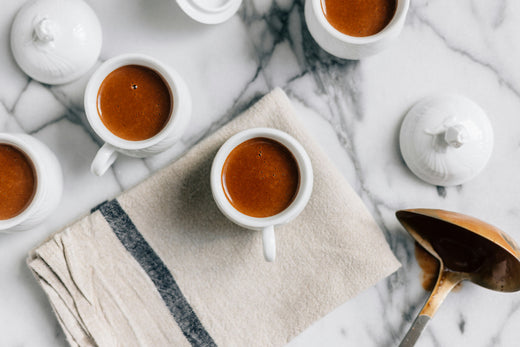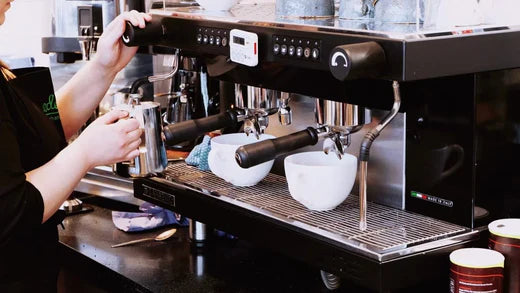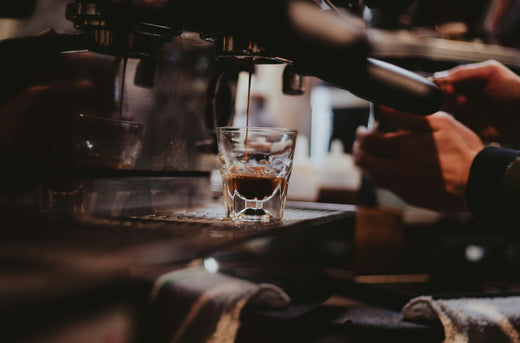How Much Caffeine is in a Shot of Espresso?
Share
You’ve probably noticed that shots of espresso are small—just 1 to 1.5 fluid ounces. But in that tiny volume lies a concentrated form of coffee flavor and, of course, caffeine. On average, a single shot of espresso contains roughly 60–65 milligrams of caffeine—give or take. However, a real-world amount of caffeine can vary from about 30 mg to over 100 mg depending on important factors like:
- Type of coffee beans (e.g., Arabica beans vs. Robusta beans)
- Grind size and consistency
- Brewing time (commonly 20-30 seconds)
- Water temperature and amount of water used
- Roast level (lighter vs. darker roasts)
The standard shot of espresso is commonly around 1 ounce in volume, extracted in approximately 20-30 seconds. But don’t let the small size fool you. Thanks to its caffeine concentration, a single espresso shot can provide a pretty swift energy boost.
Espresso vs. Regular Coffee: Surprising Comparisons
When you line up a single espresso shot (about 1 fl oz) next to an 8-ounce cup of coffee, you’d think the espresso has “less caffeine” just by looking at size. But actually, ounce-for-ounce, espresso is the more potent coffee.
- Standard cup of coffee: 8 fl oz, about 95 mg caffeine (on average)
- Single shot of espresso: 1 fl oz, about 60–65 mg caffeine
So if you only have a 1 oz shot, you might actually be getting less caffeine overall than you would from a standard cup of coffee—but if you order a double shot of espresso or even a small latte (which often has two or more shots), you can easily exceed the caffeine in a single 8 oz coffee.
Factors Affecting Espresso’s Caffeine Content
1. Type of Coffee Beans
- Arabica beans: Generally have a smoother taste and less caffeine than Robusta.
- Robusta beans: Often used in blends for their bold flavor and higher caffeine content—roughly double that of Arabica.
The type of coffee beans you (or your coffee shops) use can drastically alter the final mg of caffeine in your espresso shot.
2. Roast Level
It’s a common myth that dark roasts naturally have more caffeine. In reality, lighter roasts can retain a little bit more caffeine because the roasting process gradually reduces caffeine levels as beans are heated longer. Still, the difference between light and dark roasts in terms of total milligrams of caffeine isn’t huge, so pick what tastes good to you.
3. Grind Size and Tamping
The correct grind size for an espresso machine is typically very fine, allowing hot water to pass through the coffee grounds under 9 bars of pressure. A finer grind will often yield higher caffeine concentration, because there’s more surface area for extraction. Tamping pressure also affects the water flow—too firm, and your shot might over-extract (potentially yielding more caffeine but a bitter taste); too light, and you might end up with less caffeine and a sour flavor.
4. Brewing Time and Technique
Espresso shots typically brew between 20-30 seconds. A shorter pull (like a ristretto shot) can result in a bold flavor but slightly less caffeine, while a longer extraction can bump up the total amount of caffeine but risks over-extraction.
5. Water Temperature and Pressure
Most espresso machines are calibrated to around 195-205°F and 8-9 bars of pressure. If a machine runs hotter or higher in pressure, it may extract more soluble compounds (including caffeine) in a shorter time.
How Many Shots Are in My Favorite Coffee Drinks?
Espresso-based drink sizes can be tricky. Some baristas pull a single espresso shot, while others default to a double shot of espresso for a latte. Keep in mind that if you’re getting a grande or venti at many coffee shops, you might be looking at 2, 3, or even 4 shots of espresso. That’s a big jump in total caffeine!
- Small latte: Often has 1–2 shots
- Cappuccino: Typically 1–2 shots
- Flat whites: Usually 2 shots
- Mocha: 1–2 shots, but watch out for chocolate (extra sugar/caffeine)
Milk-to-espresso ratio can vary by café, so if you want to watch your caffeine intake, you’ll want to ask your barista how many shots are included.
Espresso vs. Drip Coffee: Which Has More Caffeine Overall?
By volume, espresso has a higher caffeine concentration—no question. But if you drink 8 ounces of regular coffee vs. a 1-ounce espresso shot, you’re likely getting more total caffeine in the regular coffee. That said, many people prefer the quick, intense jolt espresso provides, and often end up drinking multiple shots of espresso in a day.
Here’s a general rule to keep in mind:
- 1 shot of espresso (1 fl oz) ≈ 60–65 mg caffeine
- 8 oz regular coffee ≈ 95 mg caffeine
Safe Limits of Caffeine Consumption
Most healthcare professionals agree that for healthy adults, up to 400 mg of caffeine per day is usually safe. That’s about:
- 6–7 single shots of espresso, or
- 4–5 cups of coffee (8 oz each)
This can vary depending on your body weight, metabolism, and health issues like high blood pressure or anxiety. For pregnant women and individuals sensitive to caffeine, the recommended limit is usually lower. Always consult a doctor if you’re unsure about your personal safe limits of caffeine consumption.
Why Espresso Feels Stronger
While a single espresso might have less caffeine than a large cup of coffee, it often feels stronger. That’s because it’s consumed quickly (as opposed to sipping an 8-ounce or 12-ounce coffee over a longer period). Plus, espresso is a great way for coffee lovers to appreciate concentrated coffee flavor, and that short, intense caffeine hit can feel more potent.
Can You Really Overdo Espresso?
Espresso is easy to knock back—especially if you’re a big coffee fan. While enjoying a few espresso shots can be part of a healthy routine, too many in a short time might cause negative side effects like:
- Jitters or anxiety
- Rapid heartbeat
- Sleep disturbances
- Upset stomach
The key is moderation. Even if you’re used to multiple cups of coffee daily, be mindful that each shot of espresso packs a notable punch in a small package.
Tips for Moderating Your Espresso Consumption
-
Know Your Routine
If you typically have one single espresso shot in the morning and one in the afternoon, you’re probably safe. If you’re downing 4 or 5 shots at once, reconsider your approach. -
Try Different Types of Espresso Shots
If you love the taste but want less caffeine, experiment with a ristretto shot (shorter brew) or use lighter roasts which can sometimes feel milder (though roast alone isn’t the biggest caffeine determinant). -
Watch Out for Complex Drinks
Ordering a large mocha or caramel latte with two or more shots can exceed 150–200 mg of caffeine in one go. If you’re sensitive or prone to anxiety, you might want to scale back or sip slowly. -
Listen to Your Body
If you feel jittery, you can always switch to decaf or alternative coffee drinks (like a French press with a weaker brew ratio) to keep enjoying coffee without the intense buzz.
Quick FAQ: Espresso Caffeine Cheat Sheet
-
How much caffeine is in a single shot of espresso?
Usually 60–65 mg, though it can range from about 30 mg to 100+ mg. -
Is a double espresso shot just double the caffeine?
Essentially, yes—two shots mean you’ll likely have around 120 mg. -
Does espresso always have more caffeine than drip coffee?
Ounce for ounce, yes. But a full 8-ounce coffee can still contain more total caffeine than 1 ounce of espresso. -
Do darker roasts have more caffeine?
Not necessarily. Light roast beans can sometimes have slightly higher caffeine content by weight, but the difference is usually minor. -
Can I overdose on espresso caffeine?
In extreme cases, too much caffeine—espresso or otherwise—can lead to serious issues. Stick within daily safe limits (about 400 mg a day for most healthy adults).
Bottom Line
So how much caffeine is in a single shot of espresso? Typically around 60–65 milligrams of caffeine—though the number can vary based on brewing process, coffee grounds, and more. Espresso is a bold flavor experience in a small package, making it a great way for coffee lovers to get a quick, robust pick-me-up. Remember, though, that each shot of espresso counts toward your total daily caffeine intake. If you’re looking to reduce caffeine concentration, try sipping fewer shots or spacing them out through the day. And if you’re feeling the jitters, consider mixing in a half-caff shot or switching to decaf.
At the end of the day, it’s all about enjoying that espresso shot volume in moderation—and savoring the delicious bold flavor in each precious ounce. Cheers to making smart, tasty choices with your morning (or afternoon) coffee drinks!



